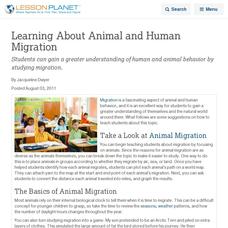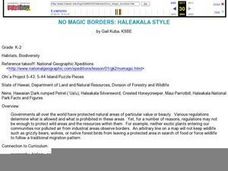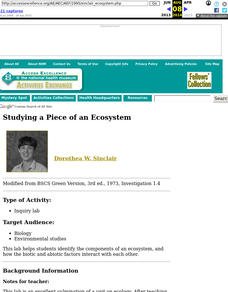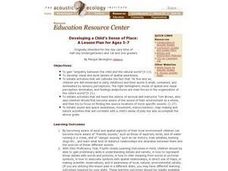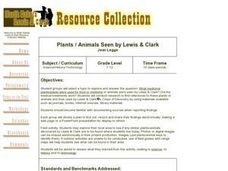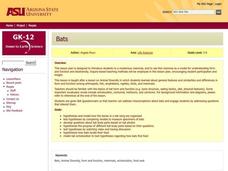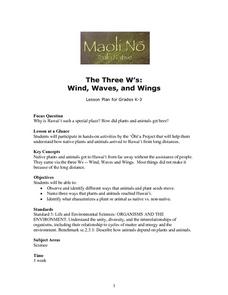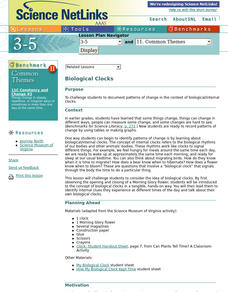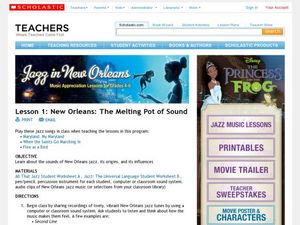Curated OER
Airplanes and Airports: How To Take Off Without Ever Leaving the Ground
Students plan an airport visit. In this Airplanes and Airports instructional activity, students observe the people, activity, and machinery at airports. Then students compare the characteristics of their observations at the airport....
Curated OER
Learning About Animal and Human Migration
Students can gain a greater understanding of human and animal behavior by studying migration.
Curated OER
No Magic Borders: Haleakala Style
Students discuss borders and boundaries. They discuss pollution and the fact that boundaries cannot stop pollution and that pollution affects even protected wildlife and plants. They participate in an activity in which they must place...
Curated OER
Food Webs
Students research what food is eaten by the following organisms: penguins leopard seals, krill, elephant seals, petrels, albatross, fur seals, squid, insects and grass. They make a food web using the data they have gathered.
Curated OER
Utah's Amazing Ecosystems
Students investigate the various ecosystems of Utah. They define key vocabulary terms, conduct research, and create an informational report on a selected ecosystem of Utah.
Curated OER
Studying a Piece of an Ecosystem
Learners carry out an outdoor land study in which they identify organisms living in the soil, and any other animals living within the site. Groups also examine abiotic factors. They respond to a series of questions concerning their data...
Curated OER
Interactions Among Living Things
Students role play predators and prey, classify organisms as predator or prey, and describe factors that affect population growth and size.
Curated OER
The Vision Quest
Fourth graders explore lives of Chief Plenty Coups and Crow Indians, focusing specifically on tradition of Vision Quests. Students identify reasons for Vision Quests, and create presentation to share information found with classmates.
Curated OER
The Life Cycle of the Butterfly
Second graders study the life cycle of a butterfly by observing metamorphosis taking place in a butterfly pavilion. Students illustrate their understandings of the body parts of a caterpillar and butterfly, as well as the life cycle,...
Curated OER
Can You Beat Jet Lag?
Learners examine the health condition of jet lag. Using mealworms, they test the effect of light on the development of them into adults. They answer discussion questions and examine the relationship of age and one's activity level.
Curated OER
Changing Ecosystems
In this ecosystem worksheet, students will review terms associated with succession in an ecosystem plus the various relationships between organisms. This worksheet has 5 matching, 9 true or false, and 6 short answer questions.
Curated OER
Do You Mean?
Students examine old sayings. In this interpretation instructional activity, students read and interpret traditional sayings or proverbs. They discuss how these sayings can help improve their lives, behavior or how they treat others.
Curated OER
Developing a Child's Sense of Place
Pupils develop empathy with the natural world; visual and aural senses of spatial awareness; and initiate sound and space awareness, movement, indoor/outdoor, map-making and nature activities that correlate with a child's sense of play.
Curated OER
Leaf - It's What's for Dinner
Pupils discover correlations in food preferences of invertebrates, and assess stream health through use of kicknets, invertebrate keys, CBL systems and probes.
Curated OER
Plants / Animals Seen by Lewis & Clark
Students conduct research to find references to plants or animals and their uses by Lewis & Clark's Corps of Discovery by using materials available such as journals, books, internet sources, library materials. Groups create a...
Curated OER
Seasonal Scroll Painting
Students take a field trip to a Botanical Gardens. They observe plants and the seasonal changes they go through and create their own scroll painting.
Curated OER
Bats
Students model how the bones in a bat wing are organized. They develop questions about bat body parts based on photographs. They hypothesize how bats locate their food.
Curated OER
The Three W's: Wind, Waves, and Wings
Pupils participate in hands-on acticities to understand how native plants and animals arrived on Hawaii from long distances without the assistance of man. They then identify what characterizes a plant or animal as native vs. non-native.
Curated OER
Diwali
Students discover festivals and traditions of South Africa. Students discuss the meaning of Diwali and why it is celebrated. They devise an assembly about the religious festival of lights. Students explain why Hindus, Jans and Sikus...
Curated OER
VERTEBRATES
Seventh graders describe the main characteristics of warm-blooded vertebrate animals. They compare and contrast the two different groups of warm-blooded vertebrate animals by looking at external, reproductive, and growth characteristics.
Curated OER
Reptiles
In this reptiles worksheet, students review reptile adaptations, amniotic egg, and the characteristics of the different reptile groups. This worksheet has 8 fill in the blank and 19 matching questions.
Curated OER
Quiz: Australian Animals
In this science worksheet, 3rd graders will focus on animals of Australia. Students will respond to nine true/false questions all pertaining to various animals which reside in Australia.
Curated OER
Water 1: Water and Ice
Students investigate water in its solid and liquid form. In this states of matter lesson, students experiment to see what happens as water goes from a solid, ice, to a liquid, water, and back again. They write about and illustrate the...
Curated OER
The Princess and the Frog
Students study the sounds of New Orleans jazz, its origins, and its influences. In this jazz music lesson, students listen to various jazz songs and discuss the songs. Students use the worksheet 'Jazz: the Universal Language' to study...

